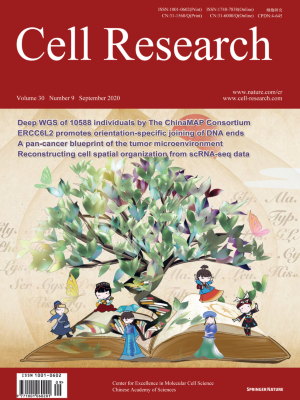
Advanced Search
Submit Manuscript
Advanced Search
Submit Manuscript
Volume 30, No 9, Sep 2020
ISSN: 1001-0602
EISSN: 1748-7838 2018
impact factor 17.848*
(Clarivate Analytics, 2019)
Volume 30 Issue 9, September 2020: 794-809 |
Immunity-and-matrix-regulatory cells derived from human embryonic stem cells safely and effectively treat mouse lung injury and fibrosis
Jun Wu1,2,3 , Dingyun Song4,5 , Zhongwen Li1,2,3 , Baojie Guo1,2,3,6 , Yani Xiao7 , Wenjing Liu1,2,3 , Lingmin Liang1,2,3,6 , Chunjing Feng1 , Tingting Gao1,2,3 , Yanxia Chen1,2,3 , Ying Li8 , Zai Wang9,10 , Jianyan Wen9,10,11 , Shengnan Yang4,12 , Peipei Liu4,5 , Lei Wang1,2,3 , Yukai Wang1,2,3 , Liang Peng9,10 , Glyn Nigel Stacey3,13 , Zheng Hu14,15 , Guihai Feng1,2 , Wei Li1,2 , Yan Huo7 , Ronghua Jin16 , Ng Shyh-Chang1,2,6 , Qi Zhou1,2,3,6 , Liu Wang1,2,3,6 , Baoyang Hu1,2,3,6,* , Huaping Dai4,5,* , Jie Hao1,2,3,*
1State Key Laboratory of Stem Cell and Reproductive Biology, Institute of Zoology, Chinese Academy of Sciences, Beijing 100101, ChinaLung injury and fibrosis represent the most significant outcomes of severe and acute lung disorders, including COVID-19. However, there are still no effective drugs to treat lung injury and fibrosis. In this study, we report the generation of clinical-grade human embryonic stem cells (hESCs)-derived immunity- and matrix-regulatory cells (IMRCs) produced under good manufacturing practice requirements, that can treat lung injury and fibrosis in vivo. We generate IMRCs by sequentially differentiating hESCs with serum-free reagents. IMRCs possess a unique gene expression profile distinct from that of umbilical cord mesenchymal stem cells (UCMSCs), such as higher expression levels of proliferative, immunomodulatory and anti-fibrotic genes. Moreover, intravenous delivery of IMRCs inhibits both pulmonary inflammation and fibrosis in mouse models of lung injury, and significantly improves the survival rate of the recipient mice in a dose-dependent manner, likely through paracrine regulatory mechanisms. IMRCs are superior to both primary UCMSCs and the FDA-approved drug pirfenidone, with an excellent efficacy and safety profile in mice and monkeys. In light of public health crises involving pneumonia, acute lung injury and acute respiratory distress syndrome, our findings suggest that IMRCs are ready for clinical trials on lung disorders.
https://doi.org/10.1038/s41422-020-0354-1